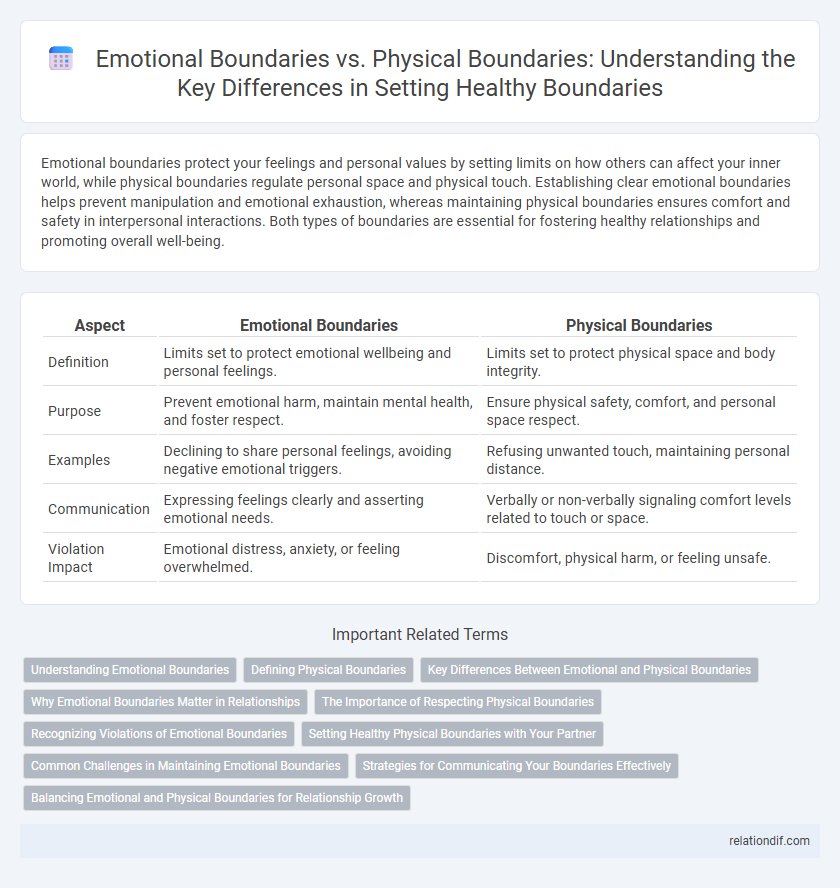Emotional boundaries protect your feelings and personal values by setting limits on how others can affect your inner world, while physical boundaries regulate personal space and physical touch. Establishing clear emotional boundaries helps prevent manipulation and emotional exhaustion, whereas maintaining physical boundaries ensures comfort and safety in interpersonal interactions. Both types of boundaries are essential for fostering healthy relationships and promoting overall well-being.
Table of Comparison
| Aspect | Emotional Boundaries | Physical Boundaries |
|---|---|---|
| Definition | Limits set to protect emotional wellbeing and personal feelings. | Limits set to protect physical space and body integrity. |
| Purpose | Prevent emotional harm, maintain mental health, and foster respect. | Ensure physical safety, comfort, and personal space respect. |
| Examples | Declining to share personal feelings, avoiding negative emotional triggers. | Refusing unwanted touch, maintaining personal distance. |
| Communication | Expressing feelings clearly and asserting emotional needs. | Verbally or non-verbally signaling comfort levels related to touch or space. |
| Violation Impact | Emotional distress, anxiety, or feeling overwhelmed. | Discomfort, physical harm, or feeling unsafe. |
Understanding Emotional Boundaries
Emotional boundaries define how individuals protect their feelings and maintain personal mental well-being by recognizing and respecting their own and others' emotional limits. Unlike physical boundaries, which relate to tangible space and touch, emotional boundaries involve managing personal vulnerability, controlling emotional exposure, and avoiding manipulation or emotional over-dependence. Understanding emotional boundaries enhances self-awareness, promotes healthier relationships, and prevents emotional burnout.
Defining Physical Boundaries
Physical boundaries are tangible limits that protect personal space and bodily autonomy, such as deciding who can touch you and how close others can stand. These boundaries help maintain comfort and safety by clearly communicating acceptable physical interactions. Defining physical boundaries involves recognizing individual preferences and asserting them consistently to prevent unwanted contact or invasion of personal space.
Key Differences Between Emotional and Physical Boundaries
Emotional boundaries regulate personal feelings, thoughts, and emotional well-being, protecting individuals from emotional manipulation or over-involvement. Physical boundaries define personal space and bodily integrity, ensuring comfort and safety by controlling who can touch or enter one's physical environment. Understanding key differences between emotional and physical boundaries is essential for maintaining healthy relationships and fostering mutual respect.
Why Emotional Boundaries Matter in Relationships
Emotional boundaries protect individual feelings and maintain personal identity within relationships, preventing codependency and emotional burnout. Establishing clear emotional limits fosters trust and open communication, enabling partners to express needs without fear of judgment or manipulation. Strong emotional boundaries contribute to healthier, more balanced connections by respecting each person's inner life and autonomy.
The Importance of Respecting Physical Boundaries
Respecting physical boundaries is crucial for maintaining personal safety and comfort, as it protects individuals from unwanted touch and intrusion. Clear physical boundaries help foster trust and mutual respect in relationships, preventing misunderstandings and conflicts. Prioritizing consent and awareness of personal space reinforces emotional well-being and reinforces a sense of autonomy.
Recognizing Violations of Emotional Boundaries
Recognizing violations of emotional boundaries involves identifying when someone dismisses your feelings, manipulates your emotions, or invades your personal mental space without consent. Emotional boundary breaches often manifest as guilt-tripping, excessive criticism, or persistent pressure to share private thoughts. Unlike physical boundaries, which are visible and tangible, emotional boundary violations require acute awareness of how others' behaviors impact your inner well-being and autonomy.
Setting Healthy Physical Boundaries with Your Partner
Setting healthy physical boundaries with your partner involves clearly communicating personal comfort levels around touch, space, and privacy to foster mutual respect and trust. Establishing limits on physical intimacy ensures both partners feel safe and valued, preventing misunderstandings and promoting emotional well-being. Consistent dialogue and consent are essential practices for maintaining these boundaries in a balanced and respectful relationship.
Common Challenges in Maintaining Emotional Boundaries
Maintaining emotional boundaries often involves challenges such as distinguishing personal feelings from others' emotions, managing guilt when asserting limits, and resisting codependency tendencies. People frequently struggle to communicate their needs clearly, leading to blurred lines between empathy and over-involvement. Developing self-awareness and consistent boundary-setting techniques is essential to overcoming these common obstacles.
Strategies for Communicating Your Boundaries Effectively
Establishing clear emotional and physical boundaries requires assertive communication that prioritizes honesty and respect. Utilizing "I" statements to express feelings and needs minimizes defensiveness and fosters understanding. Regularly reinforcing limits through consistent language and body cues enhances clarity and maintains boundary integrity.
Balancing Emotional and Physical Boundaries for Relationship Growth
Balancing emotional and physical boundaries is essential for healthy relationship growth, as emotional boundaries protect individual feelings and mental space while physical boundaries maintain personal comfort and safety. Clear communication about needs and limits in both areas fosters trust and mutual respect, promoting deeper connection without overstepping. Understanding and honoring these boundaries enables partners to create a supportive environment that nurtures emotional intimacy and physical well-being simultaneously.
emotional boundaries vs physical boundaries Infographic

 relationdif.com
relationdif.com